It was the dawn of the 21st century. The place was Skull Creek, Moffat County, Colorado, not far from the famous Dinosaur National Monument in Utah. Fossil hunters discovered the ancient remains of a dinosaur in the side of a steep slope, lying on its side. This creature would later be named Ebenezer. Over a decade later his bones finally found a home in the Creation Museum―all the way in Kentucky.
The following article is a summary of “Ebenezer: Taphonmic Patterns in the Morrison Formation and a Recently Collected Allosaurus from Northwestern Colorado,” by John Whitmore and Andrew Snelling, and of the surrounding discussion and research pertaining to it. The views expressed do not necessarily reflect those of New Creation.
But Ebenezer’s discoverers made some curious observations about his skeleton. Namely, he wasn’t all in one piece. His head and neck bones and what remains of his tail are detached from the main skeleton. How did he come to be this way? It is often said that every fossil tells a story. If that is true, then the one Ebenezer has to tell must be an intriguing one!
Who Is Ebenezer?

Ebenezer is an Allosaurus. These meat-eating theropod dinosaurs are very common throughout the United States between the Great Plains and the Rocky Mountains. When alive, Ebenezer would have weighed two tons and measured around 10 feet tall and 30 feet long.
Discovered in the year 2000, it took two more years for his complete excavation. When finished, Ebenezer’s discoverers found 56% of his total skeleton. Paleontologists only know most dinosaurs from isolated fragments, so Ebenezer was a very complete specimen by comparison. Excavators found 97% of Ebenezer’s skull, as well as 53 teeth and a hyoid (tongue) bone. This fragile hyoid bone is rarely preserved in dinosaur remains. After professional restoration, the Creation Museum put Ebenezer on display in May 2014.
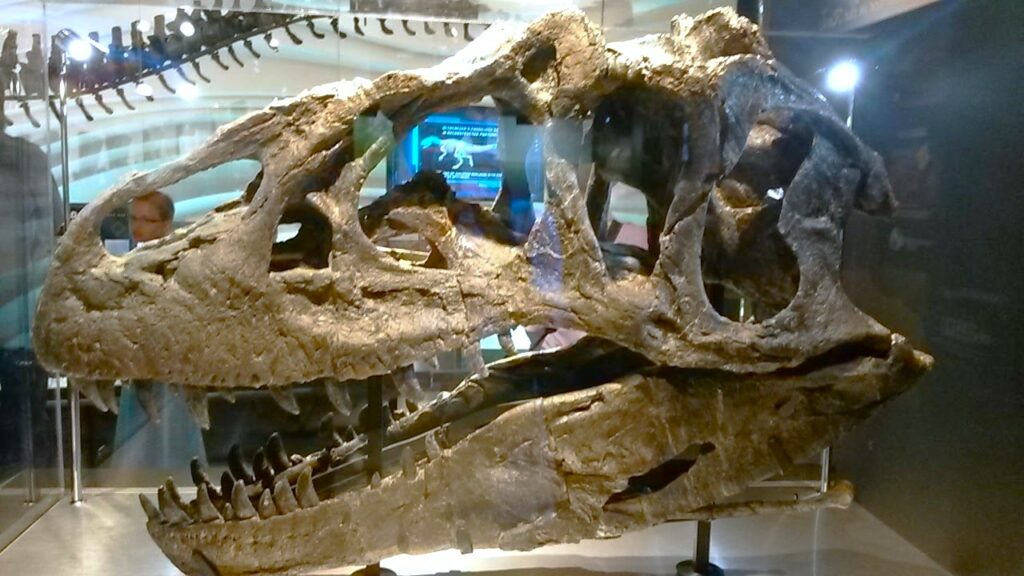
Despite what you might think, Ebenezer’s name does not come from the grumpy money-grubber of Charles Dickens’ classic novel. It actually comes from 1 Samuel 7:12. Here, Samuel sets up a rock to commemorate how God helped them defeat the Philistine army. He called this rock “Ebenezer,” meaning “stone of help.” Just as this rock helped Israel remember God’s help, Ebenezer the Allosaurus helps us piece together the long forgotten history of the Earth.
It’s a Beautiful Day in Ebenezer’s Neighborhood
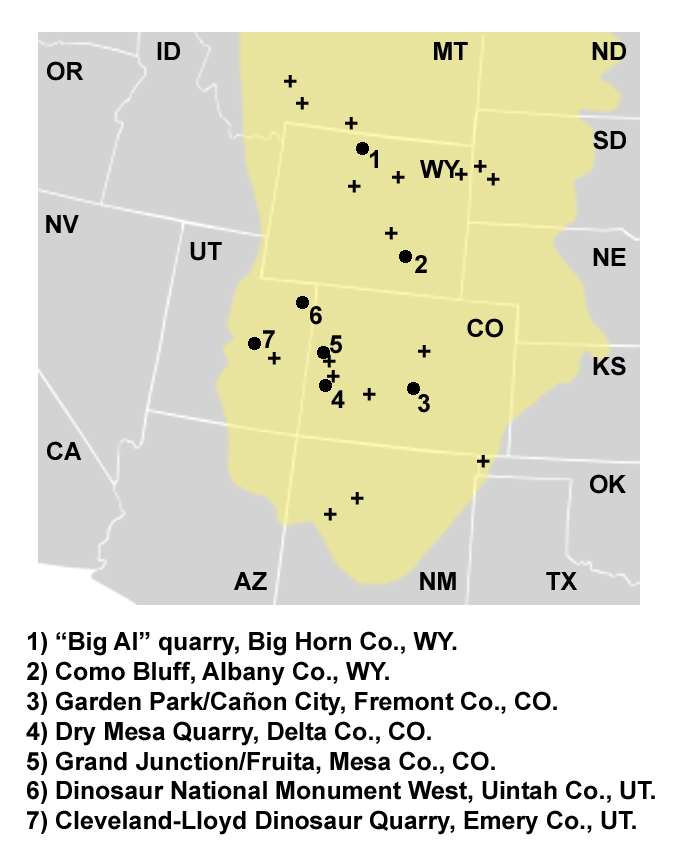
Ebenezer hails from the Morrison Formation, a unique assemblage of rock layers that carpet much of the American west in between the Rockies and the Great Plains, from New Mexico to Canada. But our “stone of help” wasn’t alone. The Morrison Formation is known for its surplus of fossils. Freshwater clams are the most common fossil here, but fossil hunters also find crocodiles, lizards, turtles, shrew-like mammals, and fish.
But, without a doubt, the most famous fossils found in the Morrison Formation are dinosaurs. As an apex predator, Ebenezer would have had a lot of wild game to choose from. He likely steered clear of the large and dangerous long-necked sauropods, such as Camarasaurus or Apatosaurus. Instead, he probably preferred smaller dinosaurs. For example, young or sickly Stegosaurus, fleet-footed Camptosaurus, or Dryosaurus. Ebenezer lived alongside other large theropods, like Ceratosaurus and the small and lithe Ornitholestes. The presence of several large theropods living in the same ecosystem suggests that they adapted to fill different niches so that they did not directly compete with each other.
Fossils suggest that conifers were the dominant tree in this ecosystem, with a supporting cast of ginkos and cycads. Instead of grasses, the main ground cover would have been ferns (especially those of the order Marattiales) and other non-flowering plants.1
How Did Ebenezer Meet His End?
Studying Ebenezer’s bones will only tell us so much about how he met his demise. To learn more, we must look more closely at the rocks containing his remains. What can they tell us?
Little Floods Every Once in a While?
The most common explanation for dinosaur fossils in the Morrison Formation is that most represent animals that perished during long-lasting droughts.2 They died in ever-dwindling river channels, likely from starvation, but perhaps from disease as well. Overtime, the carcasses would rot, while scavengers and the elements scattered many of the bones about. Then when the rains returned, flash floods washed the bones downriver to their burial place. This process repeated itself over and over again until, eventually, massive bonebeds, like the one at Dinosaur National Monument, formed.
Is this how Ebenezer died?
The Proof is in the Sediments!
A recent investigation of Ebenezer’s excavation site was carried out by young-earth geologists John Whitmore and Andrew Snelling.3 They uncovered many clues that do not appear to fit the “burial by flash floods” narrative.
For one thing, most sandstone deposits consist of well-sorted, clearly-defined horizontal layering (called bedding) and inclined layering (called cross-bedding). On the contrary, much of the sediments containing Ebenezer’s remains are poorly-sorted sandstones composed of angular- and subangular-shaped quartz grains.
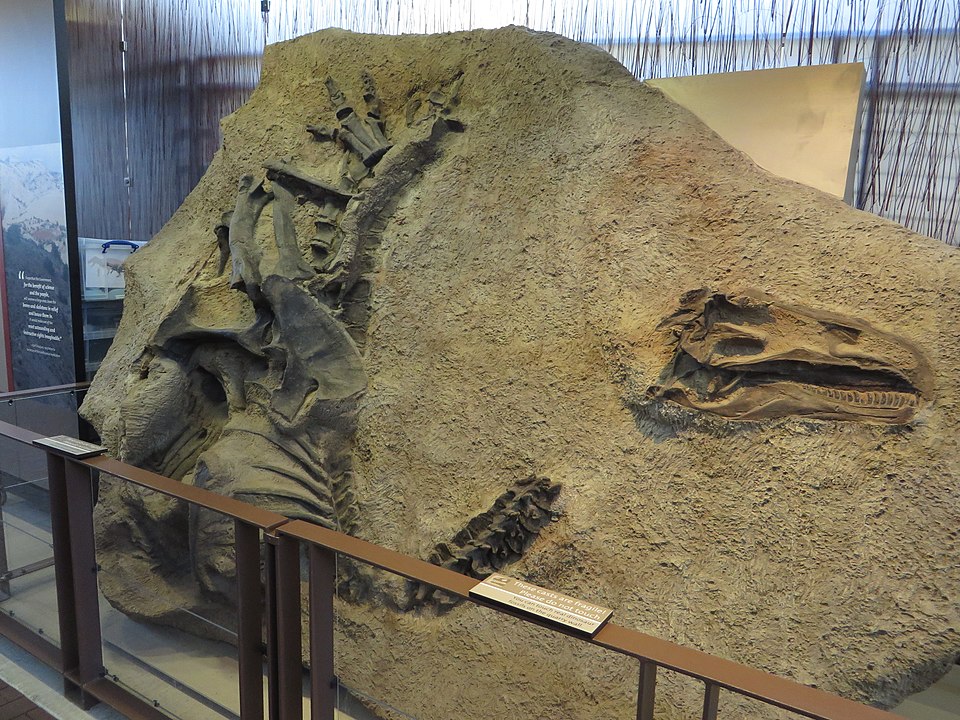
Another difficulty concerns how much of Ebenezer’s skeleton remained intact. If he lay exposed in the elements for long periods of time, the elements should have scattered his skeleton about. But many of his bones are still in their life positions. This means his tendons and ligaments still held them together at the time of his burial. This indicates a very limited amount of time elapsed since his death. However, the fact that his head and neck were separate from the rest of the body indicates his neck either broke during the transportation to his final resting place or at some point during the burial process. This would have required considerable force!
Another line of evidence against the flash flood hypothesis is that the sandstone preserving Ebenezer’s remains also contained fragments of volcanic rocks. The problem is that the nearest active volcanoes at the time were all the way in Nevada and southern California. This implies that the volcanic debris, along with the sand and Ebenezer’s remains, came from a considerable distance away from the location of their discovery. This was no local flash flood!
So while the drought-and-flash-flood hypothesis explains some lines of evidence, it does not explain other data very well. However, there is another geologic process Whitmore and Snelling point to that accounts for the evidence much better. It is similar to one postulated by other young-earth geologists, William Hoesch and Steve Austin, to explain Dinosaur National Monument: a mass debris flow.4
Cause of Burial: Mass Debris Flow
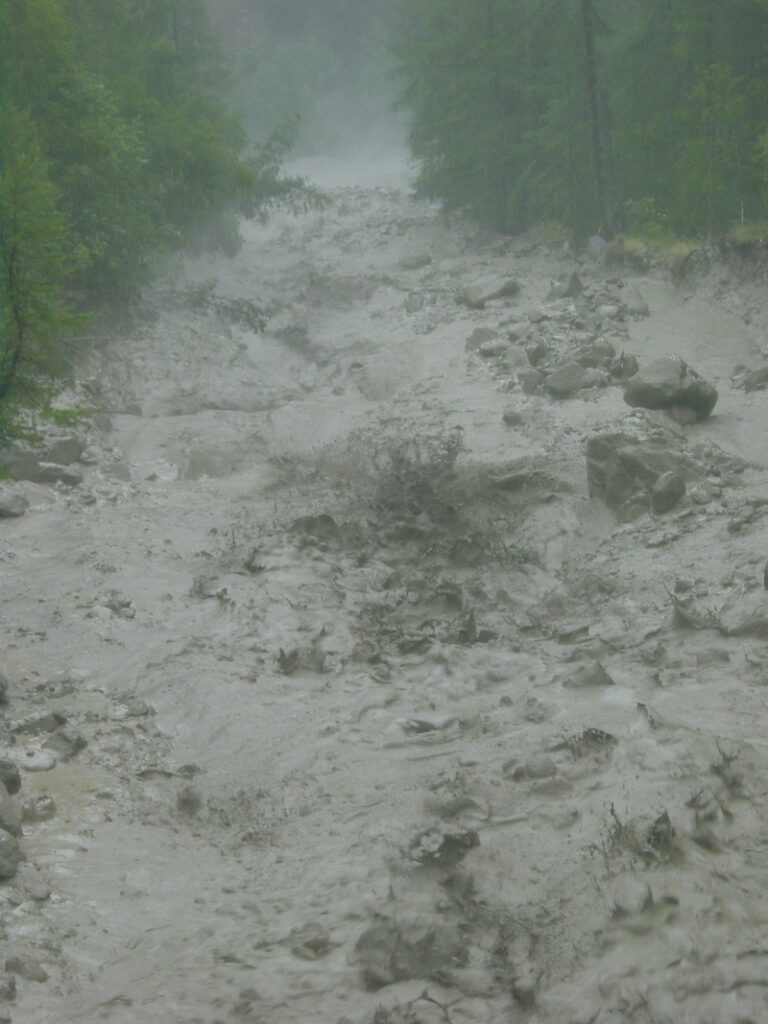
Debris flows occur when masses of water-saturated sediment flow rapidly downhill under the influence of gravity. Landslides are one such example of a debris flow. The largest landslide recorded in history occurred when Mount St. Helens erupted on May 18, 1980. A 5.1 magnitude earthquake sent two square miles of mountain careening downhill as a catastrophic mudflow at speeds of 69 to 120 mph!5 Was Ebenezer transported to his final resting place by a catastrophe such as this?
Observations such as poorly-sorted sandstone deposits composed of angular and subangular quartz grains are sterotypical evidence for mass flow processes. The occurrence of debris from Nevada or southern California serve as witness to the incredible scale of this catastrophe. This was far grander than any natural disaster we observe today or in recent history. However, it does fall in line with the sorts of processes we may expect to see in an event such as the worldwide Flood described in the Book of Genesis.
Based on this information, and the earlier work of Hoesch and Austin, Whitmore and Snelling have been able to assemble a new hypothesis explaining how Ebenezer’s final moments may have gone down. They think that siginficant amounts of volcanic activity occurred during the Flood in what is now Nevada or southern California. These eruptions triggered massive debris flows that swept across the landscape, carrying animals like Ebenezer along for the ride. On their way, the shearing forces upon Ebenzer’s body were so strong that he was literally wrenched apart. Finally, the debris flow dumped Ebenezer in his final resting place amid sand and volcanic debris that would become the Morrison Formation in Colorado.
Conclusion
Ebenezer and other fossils of the Morrison Formation are a reminder that present-day geologic processes are not adequate to explain what happened in the past. The Bible tells us that there are many things that happened in the past that are not like the present. A global Flood, for example. Ebenezer is one piece of a very large puzzle that helps us get a little better picture of the history of life on Earth.

Footnotes
- Wise, K.P. 2011. Noah’s world: same time, different place. Answers 6(4):56-63. ↩︎
- Carpenter, Kenneth. 2013. “History, Sedimentology, and Taphonomy of the Carnegie Quarry, Dinosaur National Monument, Utah.” Annals of Carnegie Museum. 81. 153-232. 10.2992/007.081.0301. ↩︎
- Whitmore, J.H., A. Snelling. 2014. “Ebenezer: Taphonomic Patterns in the Morrison Formation and a Recently Collected Allosaurus from Northwestern Colorado.” Journal of Creation Theology and Science Series C: Earth Sciences 4:1-3. ↩︎
- Hoesch, W. and Austin, S. (2004). “Dinosaur National Monument: Jurassic Park Or Jurassic Jumble?” Acts & Facts. 33 (4). ↩︎
- Tilling, Robert I.; Topinka, Lyn; Swanson, Donald A. 1990. “Eruptions of Mount St. Helens: Past, Present, and Future.” U.S. Geological Survey (Special Interest Publication). Archived from the original on October 26, 2011. ↩︎

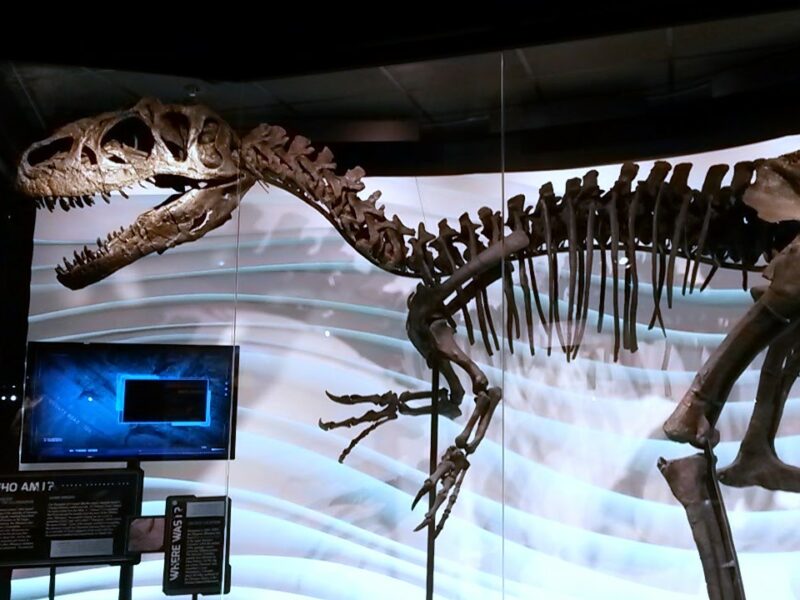
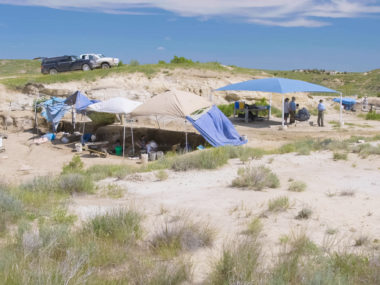

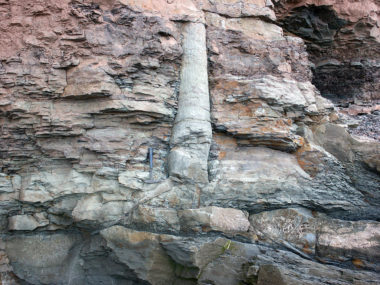


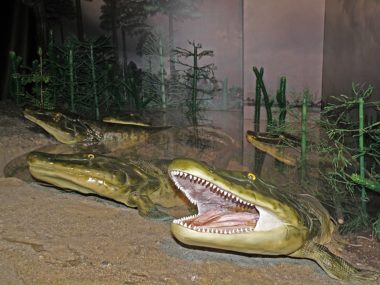




Amen. Its so hard to fossilize. In all the biffalo that were seen in the west since Columbus none have been or are beuingh fossilized. oNly special events of massive entombment can make fossils. thus only great floods.
I suggest this so called dinosaur was really a bird that is not rightly shown by artists. theroipod dinos are , I say, just flightless ground birds. just birds with teeth and tail and probably not big muscles. Evenn this creature had a wishbone.
I’m not familiar with the area, but what about burial under a colluvial or alluvial fan? That would consist of sub-angular to angular fragments and be generally poorly sorted. The lower energy involved would also allow the bones not be scattered too widely.
Poor thing belongs in a real museum where the information taught about it will be factual 🙁 survived underground for millions of years to end up there
Hello Ron,
If by “real museum” you are referring to museums that do not teach anything but absolute scientific facts, then no such thing exists. Scientists weren’t around when Ebenezer lived and died, and as such we must make inferences based on circumstantial evidence left behind in the present (e.g. fossils) in order to arrive at “tentative truths.” Old-earth scientists will be working from an old-earth paradigm that says everything on earth developed naturally over a long period of time. Whereas a young-earth scientist will be working from a Genesis paradigm, which is based on the events and timeline described in the titular Book of Genesis. For more on this topic, please see the following article: Is Creation Science Really Science?